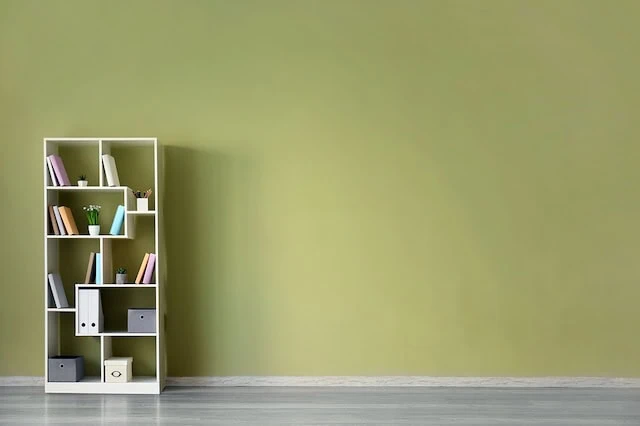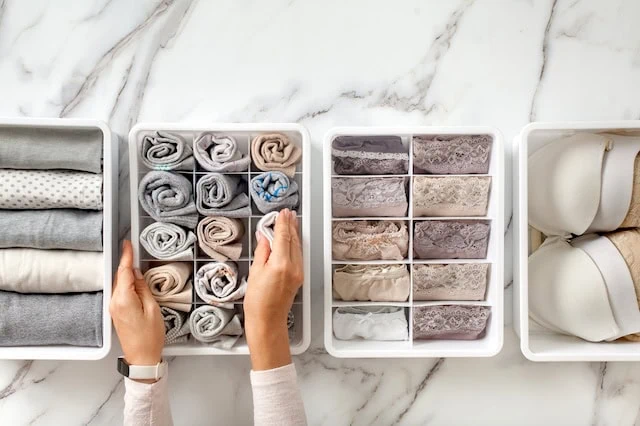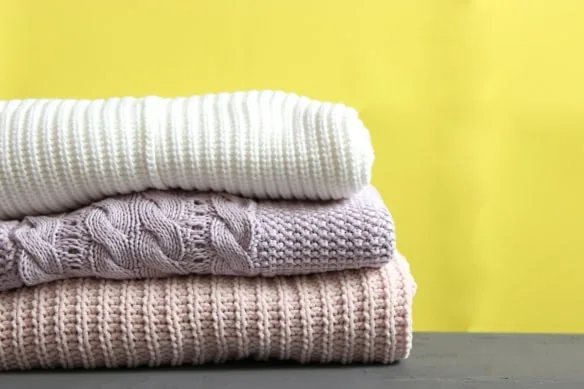It’s impressive how much stuff finds its way into our homes. Some of it we buy because we need it … or because we think we need it. Some things we bought for ourselves because we wanted them, while some things were bought for us as gifts. And if you’re anything like me, you own at least a couple things that you don’t even remember getting.
But if we want a little inner peace, some of that stuff needs to find its way out of our homes.
Whether you prefer to get rid of things little by little or conduct sweeping cleanup operations, paring down some of your accumulated things can be healthy. Tidying up can simplify making decisions, reduce stress, and even make your living space look better. And at the very least, giving a little junk the heave-ho will help you avoid crossing into hoarder territory.
Today, I’ll explain the 90/90 Rule (or the 90/90 Minimalist Rule) for decluttering so you can discover whether this neatening strategy is a good fit for you. I’ll also introduce you to a few other minimalist strategies so you have a few options in your playbook to beat back the clutter.
Table of Contents
Why Decluttering Is Important

Before we dive specifically into the 90/90 Minimalist Rule, let’s briefly review the importance of cutting down on clutter.
You don’t need to be a hoarder to benefit from getting rid of excess items you don’t need. A few reasons you should consider decluttering include:
— Easier choices. Let’s say you’re decluttering your closet. In many cases, you probably own clothes that you never wear, but that you spend time thinking about wearing when you’re picking out an outfit. Getting rid of those clothes cuts down that thought process. And in general, it’s much easier to choose from among, say, 20 dress shirts than 40.
— Simpler to find items. The more of any object you have, the harder it is to find what you need. Going back to the close, it’s hard to look through clothes that are packed together like sardines. Or think about your kitchen: How can you find your cheese grater if it’s hiding under the potato peeler and garlic press you never use?
— Improved appearance. You can highlight your favorite decorative items, rather than overwhelm the eyes.
— Easier to clean. Dust doesn’t discriminate. It lands everywhere. So if you have fewer objects, you have fewer landing spots for dust—and thus a quicker dusting process.
— Peace of mind. Clutter can be stressful. Simplicity can be soothing.
If you think decluttering would do some good for you, let’s explore how the 90/90 Minimalist Rule might be a useful method.
Related: Should I Pay Off My Mortgage Before I Retire?
What Is the 90/90 Rule?

The 90/90 Rule was developed by Joshua Fields Millburn and Ryan Nicodemus of The Minimalists podcast. And the rule is a simple one.
Just ask yourself the following two questions as you evaluate each item during the decluttering process:
1. Have I used this item in the last 90 days?
2. Will I use it in the next 90 days?
If you answer “no” to both questions, you should ditch the item. (However, Millburn and Ryan Nicodemus do allow an exception for seasonal items; you don’t have to throw out your fake Christmas tree just because it’s August and you haven’t used it since December.)
The creators acknowledge that 90 isn’t a concrete number. You can ask the questions, but use 120 days, 180 days, or any other reasonable time period. The point is to prevent you from clutching on to items you haven’t used recently and have no intention of using soon.
Related: Here’s How Much Gen-Xers Have Saved for Retirement On Average. The Number Might Surprise You
Why People Like the 90/90 Rule

The 90/90 Rule is easy to understand and implement, and it values the logical over the emotional.
Sure, you might not remember exactly when you last used an object. But if you can’t bring up any recent memories of using it, there is a good chance that it’s been more than three months.
Contrast this rule to the popular KonMari Method, which asks you to pick up items and ask yourself, “Does this spark joy?” Although it’s a yes-or-no query, whether an item “sparks joy” is an emotional question—subjective and sometimes difficult to determine. The answer might vary depending on your mood at that moment.
Related: Want to Become More Minimalist? Start by Tossing Out These Items
Potential Downfalls of the 90/90 Rule

The 90/90 Minimalism Rule might be too low of a number for some situations.
For example, I live in Wisconsin, which has four distinct seasons—including a long winter. So let’s say I was trying to use this method to clean out my closet in mid-January and I started pulling out sundresses. There is a decent chance that I wouldn’t have worn any of them within the last 90 days (mid-October) and that I wouldn’t be wearing them in the next 90 days (mid-April). But once summer eventually arrives, would I wear them often? Definitely.
The obvious solution is to change 90 to another number. But sometimes people lock themselves into the letter of the law (“it must be 90 days!”) rather than the spirit.
Another issue? It doesn’t account for expensive, useful items you use infrequently. For instance, you might have tools in your garage that you don’t use often, but you would be happy to have them if a repair needed to be done.
Like Young and the Invested’s Content? Be sure to follow us.
What Are Other Popular Decluttering Methods?

Let’s discuss a few other methods people try when they want to reduce the amount of stuff in their homes.
After all, while the 90/90 Rule has its upsides, there is no one-size-fits-all decluttering method—and one of these other strategies might be a better match for you.
KonMari Method

I briefly mentioned the KonMari Method, but let’s dive in a little deeper.
This method is named after its creator, Marie Kondo. The strategy focuses on decluttering by category (clothes, books, etc.), rather than location. It encourages people to keep objects that give them joy and discard those that don’t.
It involves six basic rules:
1. Commit yourself to tidying up.
2. Imagine your ideal lifestyle.
3. Finish discarding first.
4. Tidy by category, not by location.
5. Follow the right order.
6. Ask yourself if it sparks joy.
This is meant to be a continual process of tidying, rather than something you simply do on occasion. Similarly to how people talk about adapting new diets or workout routines, this isn’t meant to be an action you take, but rather a lifestyle change.
You don’t want to clean out a closet just for it to be filled with excess clothing again later. You want a life in which joyless items don’t exist and everything remains tidy.
Related: 14 Items to Buy in Bulk + 7 You NEVER Should
SIMPLE Method

The SIMPLE Method, developed by professional organizer Kathy Jenkins, is useful for spaces such as refrigerators, pantries, or junk drawers. SIMPLE is an anagram for the following:
— S: Sort like with like.
— I: Identify what to keep.
— M: Make a home for it.
— P: Put it in containers.
— L: Label it.
— E: Establish a routine.
The SIMPLE method is mostly … well, simple. Just follow the steps.
That said, you’re encouraged to run through this process quickly and not dwell too long on any individual item. But while it might be easy to toss useless objects from a junk drawer, this strategy might be difficult to pull off when approaching sentimental items.
Related: How to Invest HSA Funds [Level Up Your Retirement Savings]
The 20/20 Rule

The 20/20 Rule is another method created by the cohosts of The Minimalists podcast.
This rule states that you should get rid of any “just in case” objects that you could replace for under $20 in fewer than 20 minutes from your current location. The creators say “this theory likely work 99% of the time for 99% of all items and 99% of all people.”
One of the great mysteries of the world is what happens to bobby pins. Sometimes, I’m convinced my hair has miraculously eaten some of the bobby pins. Sometimes, I think they’ve jumped from my head to live in the couch cushions for a while.
But let’s pretend they didn’t disappear and I suddenly found myself with an overabundance of bobby pins I might never need. This rule would encourage me to toss them even if I wanted to hold on to them “just in case” they were needed.
The downside to this rule, though, is it remains financially wasteful. Yes, you might be able to buy a number of things for less than $20 in a pinch. But if you throw out lots of objects like this, then need to replace them, that’s a lot of unnecessary expenditures in the name of being tidy.
Related: 10 Cheapest Places to Buy a House
So, Should I Use the 90/90 Rule for Decluttering?

I can’t say whether the 90/90 Rule will work specifically for you, but I can say it’s a logical, effective decluttering method.
If you do try it out, make sure you adjust it when necessary. Cleaning out the fridge? Expired items should be tossed even if they haven’t reached 90 days. Live in a climate with similar weather year-round? This system could help you clean out your closet.
And remember: You can ultimately quit it and pick a different tidying strategy whenever you want.
You can combine this rule with others as well. For instance, you might wear a sweater frequently, but always think you look terrible in it. Ditch that sweater that isn’t bringing you joy. Love your old wedding veil? You might have no reason to wear it soon, but go ahead and keep it if you’re feeling sentimental. Have you worn that Halloween headband recently but don’t anticipate wearing it soon? It only cost you $5 from the nearby Target, so you could easily buy another one if you later want it.
Whether you use this system or another, make sure to audit your household items regularly. Stuff has a way of accumulating, and it can get out of hand if left unchecked.
Related: Do I Need a Financial Advisor? 7 Questions to Ask Yourself
Related: 6 Best Stock Recommendation Services [Stock Picking + Tips]

Stock recommendation services are popular shortcuts that help millions of investors make educated decisions without having to spend hours of time doing research. But just like, say, a driving shortcut, the quality of stock recommendations can vary widely—and who you’re willing to listen to largely boils down to track record and trust.
The natural question, then, is “Which services are worth a shot?” We explore some of the best (and best-known) stock recommendation services.
Related: 12 Best Long-Term Stocks to Buy and Hold Forever
As even novice investors probably know, funds—whether they’re mutual funds or exchange-traded funds (ETFs)—are the simplest and easiest ways to invest in the stock market. But the best long-term stocks also offer many investors a way to stay “invested” intellectually—by following companies they believe in. They also provide investors with the potential for outperformance.
So if your’e looking for a starting point for your own portfolio, look no further. Check out our list of the best long-term stocks for buy-and-hold investors.
Related: Best Target-Date Funds: Vanguard vs. Schwab vs. Fidelity

Looking to simplify your retirement investing? Target-date funds are a great way to pick one fund that aligns with when you plan to retire and then contribute to it for life. These are some of the best funds to own for retirement if you don’t want to make any investment decisions on a regular basis.
We provide an overview of how these funds work, who they’re best for, and then compare the offerings of three leading fund providers: Vanguard, Schwab, and Fidelity.
Related: 9 Best Monthly Dividend Stocks for Frequent, Regular Income

The vast majority of American dividend stocks pay regular, reliable payouts—and they do so at a more frequent clip (quarterly) than dividend stocks in most other countries (typically every six months or year).
Still, if you’ve ever thought to yourself, “it’d sure be nice to collect these dividends more often,” you don’t have to look far. While they’re not terribly common, American exchanges boast dozens of monthly dividend stocks.
Please Don’t Forget to Like, Follow and Comment

Did you find this article helpful? We’d love to hear your thoughts! Leave a comment with the box on the left-hand side of the screen and share your thoughts.
Also, do you want to stay up-to-date on our latest content?
1. Follow us by clicking the [+ Follow] button above,
2. Subscribe to The Weekend Tea, our weekly newsletter to read more about investing, spending, taxes, and more, and
3. Give the article a Thumbs Up on the top-left side of the screen.
4. And lastly, if you think this information would benefit your friends and family, don’t hesitate to share it with them!






![401(k) Contribution Limits for 2025 [Save More Next Year] 30 401k contribution limits for 2024 are higher](https://wealthup.com/wp-content/uploads/401k-contribution-limits-for-2024-are-higher-600x403.webp)
![7 Best Debit Cards for Rewards + Cash Back [2024] 31 best debit cards for rewards cash back](https://wealthup.com/wp-content/uploads/best-debit-cards-for-rewards-cash-back-600x403.webp)

